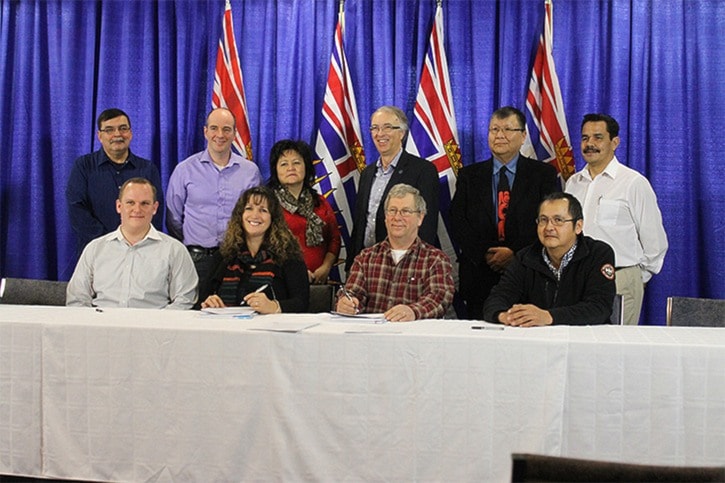Representatives from the two local governments and six First Nations groups involved in the Chinook Community Forest gathered on Feb. 12, 2016, to sign the Chinook Community Forest agreement.
During the event, which took place at the Burns Lake and District Chamber of Commerce, it was announced that the community forest licence for the Chinook Community Forest has been issued.
Bill Miller, Director of Electoral Area B of the Regional District of Bulkley-Nechako, acknowledged the importance of the new community forest.
“This community forest will help maintain the social and economic fabric of the Burns Lake area by giving many families peace of mind through sustainable employment, keeping dollars in our region, and opening up opportunities for local forest management,” he said.
“Today is a momentous day and I would like to thank all the chiefs for all their hard work,” added Miller. “It’s been a long road; it’s been four years.”
The Chinook Community Forest board has recognized that the process to get this project up and running has been much slower than anticipated.
Greig Bethel, a Spokesperson with the B.C. Ministry of Forests, said it’s not surprising that this process would take so long, considering that there are six different First Nations involved, and in addition to the proposed community forest, areas for First Nations’ woodland licenses also needed to be identified.
The Chinook Community Forest is a partnership of two local governments - Village of Burns Lake and the Regional District of Bulkley-Nechako – and six local First Nations groups - Burns Lake Band, Lake Babine Nation, Cheslatta Carrier Nation, Wet’suwet’en First Nation, Skin Tyee Nation and Nee Tahi Buhn First Nation.
Nee Tahi Buhn Chief Ray Morris said the name Chinook was chosen because the Chinook language was used on the eulachon grease trail as a trade language.
“The Chinook language will live again in Burns Lake,” he said. ”I am very happy with today’s signing and it will be a great opportunity for our community.”
Wilf Adam, Lake Babine Nation’s Chief, mentioned the 2012 explosion at Babine Forest Products that killed two workers.
“It’s been a long time coming out of a momentous tragedy that happened to this town, and I would like to thank Hampton Affiliates for sticking with us and the provincial government also for sticking with us with this agreement; the community of Burns Lake will benefit.”
Karen Ogen, Chief of the Wet’suwet’en First Nation, said the Babine Forest Products mill is vitally important to the economic stability of First Nations in and around Burns Lake.
“Many of the mill’s employees are members of the surrounding First Nations, and this community forest will keep those people working with meaningful employment - reducing economic hardship and increasing quality of life for all our communities,” she said. “I want to thank Ken Nielson and Mayor Luke Strimbold for their tireless work on this project and I welcome the new board of the Chinook Community Forest,” she added.
John Rustad, MLA for Nechako Lakes, said the new community forest will help the community heal.
“The tragic events at Babine Forest Products altered life for many families and First Nations in Bulkley-Nechako,” he said. “The creation of the Chinook Community Forest is part of the healing process, a step towards reconciliation with area First Nations, and will protect jobs for many.”
The proposed Chinook Community Forest started when stakeholders at Hampton Affiliates were deciding whether or not to move forward with the rebuilding of the Babine Forest Products sawmill after the 2012 explosion. One of the main concerns back then was the amount of timber available to supply the mill. The stakeholders stated that, to justify a rebuild, enough timber in the Lakes timber supply area needed to be available. The need for enough timber to supply the mill led local officials to propose to the provincial government that a second community forest be added to the area.
The community forest agreement will also help support the Pinnacle Pellet mill’s continuing operation in the community.
According to Strimbold, the Chinook Community Forest is unique in many ways since it is currently the largest community forest in the province and the only one to have a partnership between six First Nations and two local governments.
Back in March 2015, the village withdrew from RDBN’s Chinook Community Forest economic development function. In a subsequent interview, Strimbold said the decision was prompted by council’s desire to have direct representation on the Chinook Community Forest board and hold its own shares in the new company.
The Chinook Community Forest will run with the same legal structure as the Burns Lake Community Forest, with an annual allowable cut of 150,000 cubic metres per year. The agreement has an initial term of 25 years, and is renewable for another 25-year term after 10 years.
Harvesting is expected to begin this summer.
